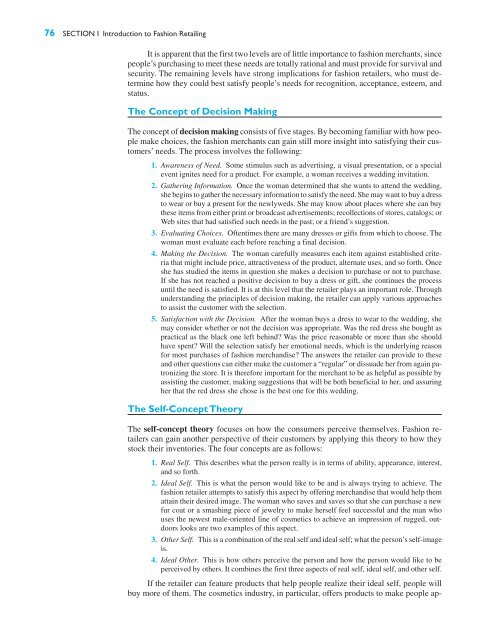Chapter 4 - Pearson
Chapter 4 - Pearson
Chapter 4 - Pearson
You also want an ePaper? Increase the reach of your titles
YUMPU automatically turns print PDFs into web optimized ePapers that Google loves.
If the retailer can feature products that help people realize their ideal self, people will<br />
buy more of them. The cosmetics industry, in particular, offers products to make people apdia76827_ch04.qxd<br />
11/29/04 7:55 PM Page 76<br />
76 SECTION I Introduction to Fashion Retailing<br />
It is apparent that the first two levels are of little importance to fashion merchants, since<br />
people’s purchasing to meet these needs are totally rational and must provide for survival and<br />
security. The remaining levels have strong implications for fashion retailers, who must determine<br />
how they could best satisfy people’s needs for recognition, acceptance, esteem, and<br />
status.<br />
The Concept of Decision Making<br />
The concept of decision making consists of five stages. By becoming familiar with how people<br />
make choices, the fashion merchants can gain still more insight into satisfying their customers’<br />
needs. The process involves the following:<br />
1. Awareness of Need. Some stimulus such as advertising, a visual presentation, or a special<br />
event ignites need for a product. For example, a woman receives a wedding invitation.<br />
2. Gathering Information. Once the woman determined that she wants to attend the wedding,<br />
she begins to gather the necessary information to satisfy the need. She may want to buy a dress<br />
to wear or buy a present for the newlyweds. She may know about places where she can buy<br />
these items from either print or broadcast advertisements; recollections of stores, catalogs; or<br />
Websites that had satisfied such needs in the past; or a friend’s suggestion.<br />
3. Evaluating Choices. Oftentimes there are many dresses or gifts from which to choose. The<br />
woman must evaluate each before reaching a final decision.<br />
4. Making the Decision. The woman carefully measures each item against established criteria<br />
that might include price, attractiveness of the product, alternate uses, and so forth. Once<br />
she has studied the items in question she makes a decision to purchase or not to purchase.<br />
If she has not reached a positive decision to buy a dress or gift, she continues the process<br />
until the need is satisfied. It is at this level that the retailer plays an important role. Through<br />
understanding the principles of decision making, the retailer can apply various approaches<br />
to assist the customer with the selection.<br />
5. Satisfaction with the Decision. After the woman buys a dress to wear to the wedding, she<br />
may consider whether or not the decision was appropriate. Was the red dress she bought as<br />
practical as the black one left behind? Was the price reasonable or more than she should<br />
have spent? Will the selection satisfy her emotional needs, which is the underlying reason<br />
for most purchases of fashion merchandise? The answers the retailer can provide to these<br />
and other questions can either make the customer a “regular” or dissuade her from again patronizing<br />
the store. It is therefore important for the merchant to be as helpful as possible by<br />
assisting the customer, making suggestions that will be both beneficial to her, and assuring<br />
her that the red dress she chose is the best one for this wedding.<br />
The Self-Concept Theory<br />
The self-concept theory focuses on how the consumers perceive themselves. Fashion retailers<br />
can gain another perspective of their customers by applying this theory to how they<br />
stock their inventories. The four concepts are as follows:<br />
1. Real Self. This describes what the person really is in terms of ability, appearance, interest,<br />
and so forth.<br />
2. Ideal Self. This is what the person would like to be and is always trying to achieve. The<br />
fashion retailer attempts to satisfy this aspect by offering merchandise that would help them<br />
attain their desired image. The woman who saves and saves so that she can purchase a new<br />
fur coat or a smashing piece of jewelry to make herself feel successful and the man who<br />
uses the newest male-oriented line of cosmetics to achieve an impression of rugged, outdoors<br />
looks are two examples of this aspect.<br />
3. Other Self. This is a combination of the real self and ideal self; what the person’s self-image<br />
is.<br />
4. Ideal Other. This is how others perceive the person and how the person would like to be<br />
perceived by others. It combines the first three aspects of real self, ideal self, and other self.
















